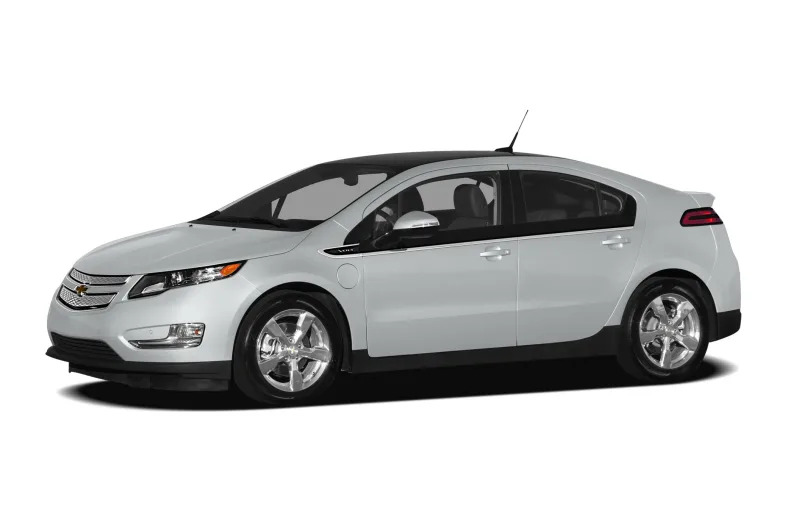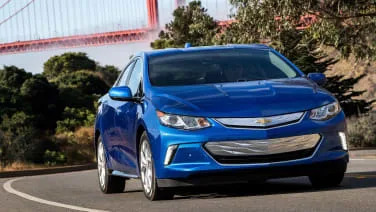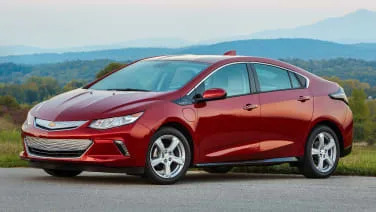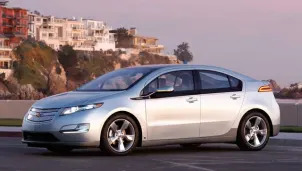Base 4dr Hatchback
2012 Chevrolet Volt
The story on the Chevrolet Volt is bigger than the machine itself. The Chevrolet Volt is an impressive engineering achievement and we are impressed with the car. We think the story about the fires has been overblown and incompletely told. Not so overblown are the government subsidies, which irk many taxpayers. But as machines go, the Volt is quite good. A four-seat hatchback, the Volt is a very good all-purpose automobile, with very low operating costs. It's electric-powered, but it carries its own gas-powered generator so when it runs out of juice it can continue for hundreds of miles. It won't leave you on the side of the road, wishing for an extension cord.
Introduced as a 2011 model, the Volt is largely unchanged for 2012. Now in its second year of production, the 2012 Volt is available in all 50 states and Canada. The 2012 Volt's standard features and options have been realigned slightly, and its base retail price actually decreases more than $1,000.
For 2012, Chevrolet has added structural enhancements to the Volt to reduce the risk of battery damage or coolant leakage in an impact. The changes followed news reports that the batteries in a couple of Volts had caught fire after government crash tests. Seldom mentioned is that the fires occurred two days or more after the Volts were crashed, and after the cars had been left sitting without the post-crash storage steps recommended by Chevrolet.
The Volt is not a traditional hybrid with a gasoline engine that frequently drives the wheels and directly propels the car. Instead, Volt's power system is similar to that used for decades in diesel locomotives. Think of the Volt's small gas engine as an electricity producer or a range extender, as GM calls it. When it runs, the gas engine turns a generator that recharges the battery pack. But the electric drive motor is always moving the car regardless of whether the engine is running.
So the Volt does not have the limited range of an all-electric car. Anyone who drives less than 30 miles a day should never have to put gas in the Volt, and drivers who can plug it in and charge it up while at work will double its plug-in range. Yet if a Volt owner forgets to plug it in, there's no fear that she won't get where she needs to go. The gasoline engine starts automatically when you run out of juice and provides the necessary electricity to propel you home. This happens seamlessly. Once the gasoline engine starts, you have a range of about 345 miles before you must stop and either fill the gas tank or plug it in. Chevrolet Volt owners will never experience the range anxiety owners of the Nissan Leaf and other all-electric cars must sometimes face.
We like the Volt's look, interior treatment and plentiful standard features. We think the Volt is a more rational choice for most consumers than the strict plug-in electric cars that are beginning …
Full Review
Full Review
A four-seat hatchback, the Volt is a very good all-purpose automobile, with very low operating costs. It's electric-powered, but it carries its own gas-powered generator so when it runs out of juice it can continue for hundreds of miles. It won't leave you on the side of the road, wishing for an extension cord.
Introduced as a 2011 model, the Volt is largely unchanged for 2012. Now in its second year of production, the 2012 Volt is available in all 50 states and Canada. The 2012 Volt's standard features and options have been realigned slightly, and its base retail price actually decreases more than $1,000.
For 2012, Chevrolet has added structural enhancements to the Volt to reduce the risk of battery damage or coolant leakage in an impact. The changes followed news reports that the batteries in a couple of Volts had caught fire after government crash tests. Seldom mentioned is that the fires occurred two days or more after the Volts were crashed, and after the cars had been left sitting without the post-crash storage steps recommended by Chevrolet.
The Volt is not a traditional hybrid with a gasoline engine that frequently drives the wheels and directly propels the car. Instead, Volt's power system is similar to that used for decades in diesel locomotives. Think of the Volt's small gas engine as an electricity producer or a range extender, as GM calls it. When it runs, the gas engine turns a generator that recharges the battery pack. But the electric drive motor is always moving the car regardless of whether the engine is running.
So the Volt does not have the limited range of an all-electric car. Anyone who drives less than 30 miles a day should never have to put gas in the Volt, and drivers who can plug it in and charge it up while at work will double its plug-in range. Yet if a Volt owner forgets to plug it in, there's no fear that she won't get where she needs to go. The gasoline engine starts automatically when you run out of juice and provides the necessary electricity to propel you home. This happens seamlessly. Once the gasoline engine starts, you have a range of about 345 miles before you must stop and either fill the gas tank or plug it in. Chevrolet Volt owners will never experience the range anxiety owners of the Nissan Leaf and other all-electric cars must sometimes face.
We like the Volt's look, interior treatment and plentiful standard features. We think the Volt is a more rational choice for most consumers than the strict plug-in electric cars that are beginning …
Hide Full Review
Retail Price
| Engine | |
| MPG | 35 City / 40 Hwy |
| Seating | 4 Passengers |
| Transmission | 1-spd auto |
| Power | 149 @ rpm |
| Drivetrain | front-wheel |





